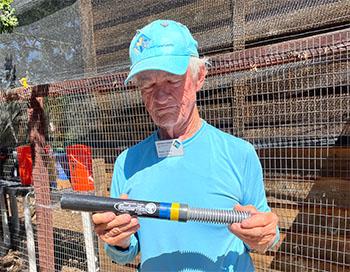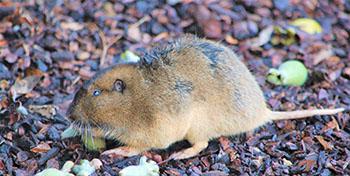Summer 2022
Gophers, Moles, and Voles

Interview with “Mr. Gopher” Bob Archer
by David George
I caught up with Contra Costa Master Gardener “Mr. Gopher,” Bob Archer, the other day at the demonstration garden in Walnut Creek, Our Garden. Even though Bob is relatively new to the program, he is an experienced gardener and successful gopher trapper. He worked with UCCE scientists to approve a new and effective device to eliminate destructive gophers from gardens. He shared with me both his background and trapping techniques for gophers and other rodents and is demonstrating the new device and technique in a video included in this article.
What did you do prior to being certified as a Contra Costa County Master Gardener volunteer, Bob?
“I flew heavy-lift helicopters while serving in the Army during the Vietnam war until I was shot down about three years into my tour of duty. Those copters were very important to the war effort and could lift as much as 15 tons, such as damaged fighter jets or bridge segments. After that, the Army paid for my college education where I earned a master’s degree in environmental science at UT Houston. I used my degree in various roles at both Kaiser Aluminum and Ford Aerospace (Loral) until retiring in 2007 with a permanent disability caused by PTSD. I gardened for therapy until joining the Master Gardener program in 2019 – where I still garden for therapy! I’m also interested in large-scale composting, irrigation systems, and growing great citrus – I donated 1,500 lbs. of citrus to Our Garden last year.”
“Well, gophers of course are my primary focus now, and also garden rat control. The traps I use also state they work on moles, but I don’t waste effort on moles. Unless they are digging up your lawn, they really are harmless to your garden. They eat earthworms, grubs, and other small creatures in the ground and don’t eat plants.”
What’s the best way to control gophers in an eco-friendly and effective fashion?
“Not with poison! Poisons have a 'last alternative' role in the Integrated Pest Management (IPM) approach. Victor snap traps are effective for mouse, rat, and vole control. Use peanut butter or almonds as bait and cover the set trap with a box or other covering to protect pets, kids, or un-targeted wildlife from being injured or killed.
"For gophers, you can use spring-loaded or wind-up traps that capture and kill gophers in their tunnels. Macabee spring-loaded traps are popular and can be found in local hardware stores and garden centers. Cinch makes a popular wind-up gopher trap, and there are other alternatives that can easily be found through a web search. My favorite, the one I worked with UC scientists on to get approved by UCANR, is called the “Gopher Hawk.” It is also spring-loaded with a trigger, but works in a completely different and, in my opinion, easier way for most home gardeners. It’s a two-foot long post with a trigger and snare at one end.
"Once you find a gopher tunnel with a probing rod, you lower the snare end of the post vertically into the tunnel then cock it. You’ll know the trap has sprung from a distance because yellow markings appear near the top. I demonstrate how to use this trap in the included video, which I encourage you to watch!”
Okay, we will. But first, what are some of your more interesting stories coming from working with the public on rodent control?
“Just a week ago, I volunteered at the Brentwood Farmer’s Market MG booth. Afterward, my son and I went cherry picking in one of the famous orchards out there. After a bit, my son came over and said, ‘Dad, you’ve got to come see this’. Right in broad daylight in front of us, a gopher poked his head out of his feeding hole, ran about two feet over to a ripe cherry on the ground, grabbed it with its jaws, and ran back into his tunnel. No doubt, he had eaten quite a few cherries that day, because he was a big one! And at another market MG booth, a guy swore that all he had to do to kill gophers was to shove a steel pipe into their tunnels. I don’t recommend that approach!”
Thanks, Bob for sharing your gopher techniques and stories. We’re fortunate to have you as one of our ambassadors to the public. And yes, we’re going to watch that video right now!
Article by David George, UC Master Gardener of Contra Costa County
Photo & video credits: David George and Shutterstock
